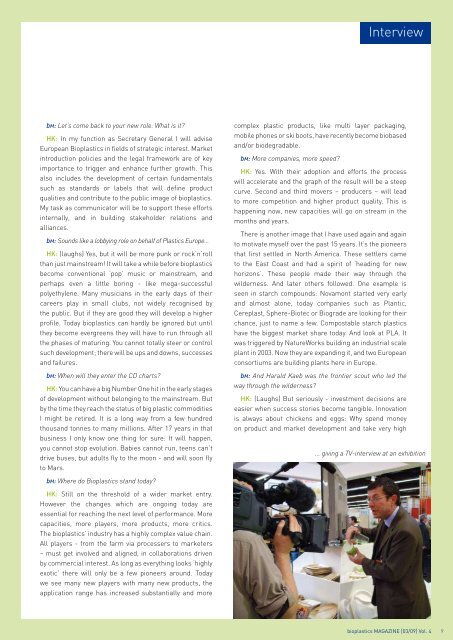bioplasticsMAGAZINE_0903
bioplasticsMAGAZINE_0903
bioplasticsMAGAZINE_0903
You also want an ePaper? Increase the reach of your titles
YUMPU automatically turns print PDFs into web optimized ePapers that Google loves.
Interview<br />
bM: Let‘s come back to your new role. What is it?<br />
HK: In my function as Secretary General I will advise<br />
European Bioplastics in fields of strategic interest. Market<br />
introduction policies and the legal framework are of key<br />
importance to trigger and enhance further growth. This<br />
also includes the development of certain fundamentals<br />
such as standards or labels that will define product<br />
qualities and contribute to the public image of bioplastics.<br />
My task as communicator will be to support these efforts<br />
internally, and in building stakeholder relations and<br />
alliances.<br />
bM: Sounds like a lobbying role on behalf of Plastics Europe…<br />
HK: (laughs) Yes, but it will be more punk or rock’n’roll<br />
than just mainstream! It will take a while before bioplastics<br />
become conventional ‘pop’ music or mainstream, and<br />
perhaps even a little boring - like mega-successful<br />
polyethylene. Many musicians in the early days of their<br />
careers play in small clubs, not widely recognised by<br />
the public. But if they are good they will develop a higher<br />
profile. Today bioplastics can hardly be ignored but until<br />
they become evergreens they will have to run through all<br />
the phases of maturing. You cannot totally steer or control<br />
such development; there will be ups and downs, successes<br />
and failures.<br />
bM: When will they enter the CD charts?<br />
HK: You can have a big Number One hit in the early stages<br />
of development without belonging to the mainstream. But<br />
by the time they reach the status of big plastic commodities<br />
I might be retired. It is a long way from a few hundred<br />
thousand tonnes to many millions. After 1 years in that<br />
business I only know one thing for sure: It will happen,<br />
you cannot stop evolution. Babies cannot run, teens can’t<br />
drive buses, but adults fly to the moon - and will soon fly<br />
to Mars.<br />
bM: Where do Bioplastics stand today?<br />
HK: Still on the threshold of a wider market entry.<br />
However the changes which are ongoing today are<br />
essential for reaching the next level of performance. More<br />
capacities, more players, more products, more critics.<br />
The bioplastics’ industry has a highly complex value chain.<br />
All players - from the farm via processers to marketers<br />
– must get involved and aligned, in collaborations driven<br />
by commercial interest. As long as everything looks ‘highly<br />
exotic’ there will only be a few pioneers around. Today<br />
we see many new players with many new products, the<br />
application range has increased substantially and more<br />
complex plastic products, like multi layer packaging,<br />
mobile phones or ski boots, have recently become biobased<br />
and/or biodegradable.<br />
bM: More companies, more speed?<br />
HK: Yes. With their adoption and efforts the process<br />
will accelerate and the graph of the result will be a steep<br />
curve. Second and third movers – producers – will lead<br />
to more competition and higher product quality. This is<br />
happening now, new capacities will go on stream in the<br />
months and years.<br />
There is another image that I have used again and again<br />
to motivate myself over the past 1 years. It’s the pioneers<br />
that first settled in North America. These settlers came<br />
to the East Coast and had a spirit of ‘heading for new<br />
horizons’. These people made their way through the<br />
wilderness. And later others followed. One example is<br />
seen in starch compounds: Novamont started very early<br />
and almost alone, today companies such as Plantic,<br />
Cereplast, Sphere-Biotec or Biograde are looking for their<br />
chance, just to name a few. Compostable starch plastics<br />
have the biggest market share today. And look at PLA. It<br />
was triggered by NatureWorks building an industrial scale<br />
plant in 2003. Now they are expanding it, and two European<br />
consortiums are building plants here in Europe.<br />
bM: And Harald Kaeb was the frontier scout who led the<br />
way through the wilderness?<br />
HK: (Laughs) But seriously - investment decisions are<br />
easier when success stories become tangible. Innovation<br />
is always about chickens and eggs: Why spend money<br />
on product and market development and take very high<br />
... giving a TV-interview at an exhibition<br />
bioplastics MAGAZINE [03/09] Vol. 4 9


















